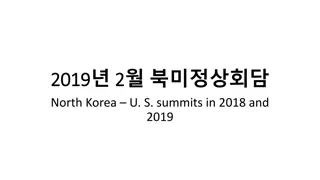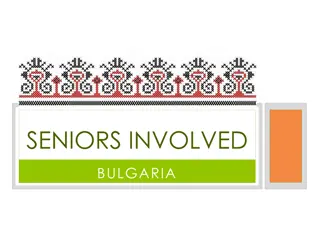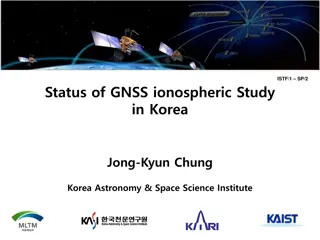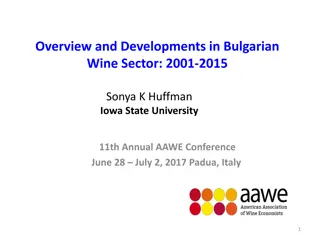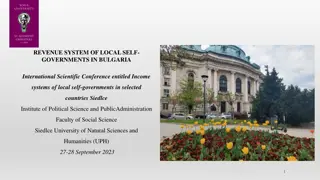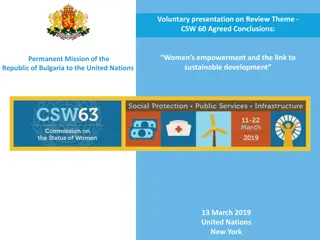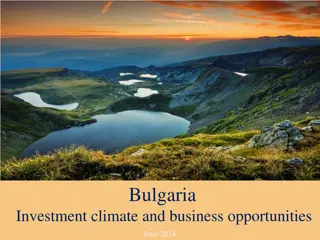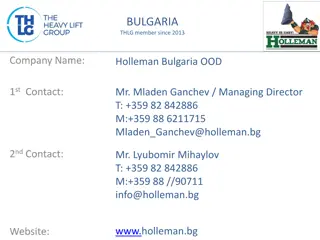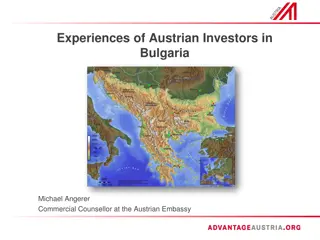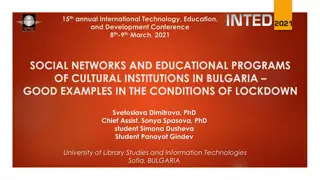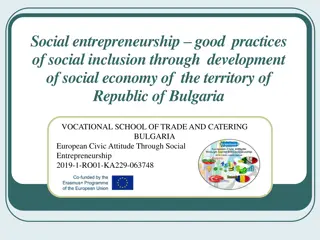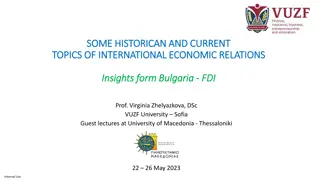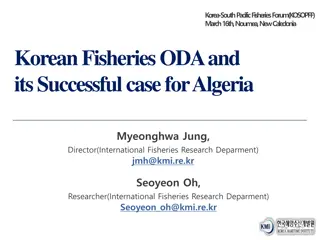Strategic Model for Sofia Tech Park Development: Insights from Korea-Bulgaria Knowledge Sharing Program
This article presents the knowledge sharing program between Korea and Bulgaria focusing on building a strategic model for the development of Sofia Tech Park. It covers theoretical backgrounds, the development of science and technology parks, and factors contributing to successful park development. The program aims to assist Bulgaria in harnessing innovation policy and fostering technology-based businesses. Key elements include strategic planning, operations, infrastructure development, business incubation, technology transfer, and more.
Download Presentation

Please find below an Image/Link to download the presentation.
The content on the website is provided AS IS for your information and personal use only. It may not be sold, licensed, or shared on other websites without obtaining consent from the author. Download presentation by click this link. If you encounter any issues during the download, it is possible that the publisher has removed the file from their server.
E N D
Presentation Transcript
2015/16 Korea-Bulgaria Knowledge Sharing Program Building a Strategic Model for Sofia Tech Park s Development: Strategic Issues and Planning Guidelines Taeyoung Shin & Anna-Marie Vilamovska Feb. 24, 2016 Ministry of Strategy and Finance of Korea Korea Development Institute (KDI) Sofia Tech Park Jsc
Table of Contents Table of Contents Introduction Theoretical backgrounds and development of S&T park Korean experiences : S&T parks Assessment of current state of Bulgaria s innovation system and Sofia Tech Park Guidelines for planning Concluding remarks and policy suggestions 2
Introduction KSP (Knowledge Sharing Program) between Korea and Bulgaria. KSP aims to share Korea s development know-how, assisting the partner countries and working towards lessening the knowledge divide. STP/TIN project of Bulgaria Initial request Strategic planning and operations, Facilities and infrastructure development, Business incubation, iv) technology transfer, Internalization, and others Agreement : Strategic issues and planning guideline for STP s development Purposes of the study To provide policy advice to Bulgarian Government To assist harnessing innovation policy and developing the STP/TIN project, focusing on TBI 3
Theoretical Backgrounds Theoretical Backgrounds Innovation Cycles Research & Development Business Strategy & Model Business Success (PLC) Commercialization Value Chains Demo to commercial Research Pilot manufacturing marketing Services Revenue Death Valley Technology Investment flow Business Cumulative investment Research/Science Park Tech Park / Technopolis Industrial Park Innovation Cluster 4
Development of S&T Parks Development of S&T Parks Several cases Silicon Valley in USA Tsukuba Science City in Japan Sophia-Antipolis in Frnce Daedeok Science Town in Korea Main factors for successful development Dedication and leadership of participants from universities and business (or government) Interaction between research organizations and industries in developing new technology-based business Sustained government policy creating STI-friendly environment including infrastructure and human resources. Developed NIS/RIS: increased STI inputs and outputs. Cultural/social backgrounds nurturing entrepreneurship 6
Continued. Some factors are often pointed out when successful achievement is not exhibited. Strong dependence on government support which is not continued with a consistency Lack of innovation culture and resources; particularly entrepreneurship Lack of network of innovation units between universities, business and government Low STI capacity Underdeveloped industrial eco-system 7
Korean Experience : S&T Parks Korean Experience : S&T Parks 8
Continued. The R&D Special Zone aims To grow towards an innovation cluster To foster development of technology-based startups. This approach is pursued by the Ministry of Science, ICT and Future Planning (MSIP). It can be said that the R&D Special Zone is developed in a science-push approach (started from S&T policy) Techno-park in a demand-pull approach (started from industrial policy). 9
Continued. 10
Continued. No. Names Year Location Specialization Areas Homepages Automotive, electronics, bio, display, informati on & video 1 Chungnam TP 1995 Cheonan-si http://www.ctp.or.kr/ 2 Gyeonggi TP 1997 Ansan-si ICT, automotive, robot, bio-tech http://www.gtp.or.kr/ Automotive, bio-materials, electronics, robot, 3 D 3 Gwangju TP 1997 Gwangju-si http://www.gjtp.or.kr/ 4 Daegu TP 1998 Daegu-si Nano, mobile, bio-health, Korean medicine http://www.ttp.org/dtp/DtpMain.dtp 5 Pohang TP 1999 Pohang-si Metal, energy parts/materials, bio, S/W Intelligent machinery, material/parts, aero-spac e, ship-building, ICT New materials, ceramics, energy, bio, http://www.pohangtp.org/ 6 Gyeongnam TP 2000 Changwon-si http://www,gntp.or.kr/ 7 Gangwon TP 2002 Chuncheon-si http://www.gwtp.or.kr/ 8 Daejeon TP 2002 Daejeon IT, bio, nano Bio, solar energy, electronics, machinery, semi- conductor New materials, ceramics, laser, polymer http://www.daejeontp.or.kr/index.php 9 Chungbuk TP 2003 Cheongju-si http://www.cbtp.or.kr/ 10 Jeonnam TP 2003 Suncheon-si http://www.jntp.or.kr/ 11 Ulsan TP 2003 Ulsan-si Chemical, auto parts http://www.utp.or.kr/ Microsystem packaging, next generation packa ging, 12 Seoul TP 2004 Seoul http://www.seoultp.or.kr/ 13 Gyeongbuk TP 2006 Gyeongsan-si Digital parts, energy, fabrication,bio, mobile http://www.ktp.or.kr/ Automotive, machinery, green energy, foods, n ew materials Auto parts, nano-materials, bio-industry 14 Jeonbuk TP 2007 Jeonju-si http://www.jbtp.or.kr/ 15 Incheon TP 2010 Incheon-si http://www.itp.or.kr/ Intelligent machinery, precision parts, die-casti ng/furnace, digital contents, bio-health, 16 Busan TP 2010 Busan-si http://www.btp.or.kr/ 17 Jeju TP 2011 Jehu-si bio-convergence, marine bio http://www.jejutp.or.kr/index.htm 18 Gyeonggi-Daejin TP 2014 Pocheon-si Environment http://gdtp.or.kr/index.php 11
Continued. The mission and goal of techno-park in Korea Primarily placed on the regional economic development, Techno-park as an innovation hub of the region. Sizable investment has been made to build 18 techno-parks across the country. Government enacted a special law for development and support of the techno- park, Act on special cases concerning support of techno-parks. 12
A Case Study: Chungnam Techno Park A Case Study: Chungnam Techno Park 1,538 machines 400 member companies 14,268 cases 183 startups incubated Sales : 121 million dollars Employment : 1,825 Common Equipment 2,342 pre-engineering training Hiring promotion : 274 persons Education/ Training Business Incubation Photo-voltaic test-bed project 2ndbattery R&D Veterinary medicinal product hub Integrated Business Support Joint R&D Technologies transfer : 62 Annual conference & exhibition Integrated supports : marketing/technology market/consulting, etc. Networking Open innovation networking : 9,930 participants Spatial proximity hub, Chungnam Tech-Biz Zone Community networking : local universities and researchers
Overall performance: incubation Overall performance: incubation Period : 2000~2009 14
Campus plan Campus plan 15
Development roadmaps Development roadmaps 16
Organization Organization 17
Major Functions (MF) : Incubation Major Functions (MF) : Incubation 18
MFs : Technology Transfer and Commercializatio MFs : Technology Transfer and Commercialization n 19
MFs : Business Support Services MFs : Business Support Services 20
MFs : CTP & RIS MFs : CTP & RIS 21
Assessment of Bulgarian Innovation System Assessment of Bulgarian Innovation System Variables Units in bn in bn % of GDP % % % % of GDP % of GDP % of GDP 2014 42.1 22.1 3.2 1.7 10.6 -1.6 -1.5 18.9 0.0 GDP Exports Net FDI GDP growth Unemployment Inflation rate Government deficit Government debt Current account balance Long-term credit ratings Moody s S&P Fitch Baa2 stable BB+ stable BBB- stable 22
Share of innovative enterprises, 2010 Share of innovative enterprises, 2010 12 (% of all enterprises) all enterprises) 12 (% of 23
R&D Investment in Bulgaria: 2013 R&D Investment in Bulgaria: 2013 24
Patents granted Patents granted USPTO 2007 2008 2009 2010 2011 Bulgaria Hungary Romania Turkey Croatia Finland 6 16 66 12 16 14 824 36 46 8 19 16 864 58 91 16 29 9 43 100 34 41 16 951 47 11 19 15 850 1143 EPO 2007 2008 2009 2010 2011 1.1 4.6 0.1 1.3 1.1 109 Bulgaria Hungary Romania Turkey Croatia Finland 0.8 3.5 0.2 0.5 3.2 144 0.5 4.8 0.3 0.7 2.9 0.7 3.8 0.2 0.8 3.4 0.4 5.8 0.1 1.2 2.3 154.3 124.3 126.6
Global Innovation Index (2015) Global Innovation Index (2015) Index (Score 0~100, or value) Rank (1) Global Innovation Index (2) Innovation Output Sub-Index (3) Innovation Input Sub-Index (4) Innovation Efficiency Ratio (5) By Factors Institutions Human capital & research Infrastructure Market sophistication Business sophistication Knowledge & technology outputs Creative outputs 42.2 38.2 46.1 0.8 39 35 49 21 69.7 32.2 43.3 48.9 36.4 27.8 41.1 45 58 53 61 60 102 34 26
STI Governance STI Governance 27
Bulgarian Academy of Science Bulgarian Academy of Science PARLIAMENT OF BULGARIA BULGARIAN ACADEMY OF SCIENCE BOARD OF TRUSTEES PRESIDENT OF BAS BAS GENERAL ASSEMBLY Assembly of Academicians and corresponding Members of BAS BAS EXECUTIVE COUNCIL SPECIALIZED AND SUPPORTING UNITS ADVISORY SCIENTIFIC COUNCIL Units carrying out business activity RESEARCH DIVISIONS INFORMATION AND COMMUNICATION SCIENCES AND TECHNOLOGIES ENERGY RESOURCES AND ENERGY EFFICIENCY NANO SCIENCES, NEW MATERIALS AND TECHNOLOGIES BIOMEDICINE AND QUALITY OF LIFE BIODIVERSITY, BIORESOURCES AND ECOLOGY CLIMATE CHANGE, RISK AND NATURAL RESOURCES ASTRONOMY, SPACE RESEARCH AND TECHNOLOGIES CULTURAL, HISTORIAL HERITAGE AND NATIONAL IDENTITY MAN AND SOCIETY Functional interconnection Accountability Electability 28
SWOT Analysis SWOT Analysis STRENGTH WEAKNESS High share of university graduates Tradition in the fundamental research Highly qualified researchers in the field of physics, chemistry, computer technologies and biotechnologies A member of EU Government s awareness of the importance of STI development Inflows of FDI Inefficiency of STI governance for coordin- ation of horizontal issues: lack of effective mechanisms for priority setting, and no integration between the research and inno- vation policy at the national level Low shares of GERD & BERD/GDP Limited business-academia cooperation Brain drain and aging of highly qualified professors and researchers Low GDP share of manufacturing industry and weak industrial ecosystem THREATS Opportunities for qualified researchers to work abroad with better conditions Rapid change in global STI environment Acceleration of the cycle of technological innovation Deepening globalization and competition. OPPORTUNITIES Innovation and entrepreneurial culture of the young generation Bulgarian Diaspora scientists and potential of brain circulation Increasing global research collaboration trends and open innovation 29
Sofia Tech Park and TIN Sofia Tech Park and TIN The objectives for developing STP/TIN were to: Strengthen the competitiveness of science and entrepreneurship in Bulgaria by improving the exchange of knowledge between academia and the business community. Become a platform for the development of start-up companies and innovative ideas. Accelerate the process of commercialization of research. The key components of STP/TIN are: A laboratory complex consisting of 11 on-site laboratories in the fields of ICT, life sciences and energy, An incubator hosting innovative startup and spin-off companies, A forum hosting R&D&I events; international and national. A Museum the Experimentarium 30
STP/TIN : Operational Framework STP/TIN : Operational Framework 31
A Conceptual Model of STP/TIN : Incubation A Conceptual Model of STP/TIN : Incubation 32
Process of Planning Process of Planning 33
Issues to be considered in Planning Issues to be considered in Planning Vision / Goals & objectives / Direction of development / Strategies Assessment of STI activity/environment, and RIS/NIS Macro-economic analysis/framework condition industrial analysis STI capacity: university, research institute, enterprise, and RIS/NIS, etc. Analysis of national strategies, including Bulgaria 2020 and Smart Specialization Strategy, etc. Structure and governance Structured process of decision-making Coordination of horizontal issues Priority setting Scope of STP/TIN business R&D Business incubation Technology transfer and commercialization Others 34
Continued. Technology incubation strategy Pre-incubation In-wall incubation Out-wall incubation Post-incubation: exit strategy (M&A Strategy, registration of stock market, etc.) Business support programs Value chains of startups Contact points/program for enterprises with experts Network-learning programs Technology management programs for CEOs Technology transfer and commercialization Technology Transfer Center (TTC) Technology Licensing Office (TLO) Technology Holdings Company (THC) 35
Continued. Regional/national innovation system Concept of regional innovation platform STP/TIN as a hub of RIS/NIS Requirement of regional/national innovation ecology Techpark network at Bulgaria and global level Time table and budget Time schedule of each program Funding schemes for each program 36
Suggestions in management and policies Medium- and long-term development plan of the Sofia Tech Park Development roadmaps, including programs/activities, infrastructure, research and production facilities, and other Linkage between the plan and the national strategies Incubation Entry criterion: business plan, financial state, and technological potential Recruit of tenant startups Office provision R&D Securing R&D fund for utilizing 20 per cent of labs capacity Joint R&D: linking startups, labs, university, PROs and others Management plan of R&D projects 37
Continued. Technology transfer and commercialization Needs survey for industrial technologies Database of technologies to be transferred: stock-taking of patents owned by universities/PROs (or overseas sources) Technology marketing plan Business support programs Survey of needs for business support services created by the tenant firms Support plan for technology development & commercialization, financing, marketing and networking, etc. Regional/national innovation system Networking between industry, university, PROs and other related institutions in the region Network-learning programs in the strategic areas of ICT, life science and energy. Plan for public relation: vision, mission, objective and activities of STP/TIN as hub of regional/national innovation system 38
Continued. Others Establishing STI policy research unit in STP/TIN Studying institutional reform for innovation-friendly environment Promotion for recruiting tenants. 39
Policy suggestions at the government level Policy suggestions at the government level Increase in R&D investment : The increase in the government R&D investment will stimulate the private R&D, and hence the STI environment will improve at the national level. The government should keep the target to increase R&D investment to 1.5 per cent by 2020. Pursuing target-oriented R&D projects : The top-down approach is necessary to strengthen the linkage of STI policies to the national strategy such as Bulgaria Horizon 2020 and Smart Specialization, etc. Such policy will eventually increase the technological competitiveness of the industry. This is also a preferable approach to strongly link between research labs and startups. Implementing R&D management system : To increase rationality and transparency, it is necessary to implement R&D management system, in which the evaluation and feedback system plays a central role. In so doing, large-scale R&D could be undertaken to tackle socio-economic issues. R&D management includes technology foresight, planning, budget control, evaluation, and others. 40
Continued. Improvement of government policy capacity : It is necessary to improve the coordination system for horizontal issues. This also implies a reform of STI governance at the government level. In addition, redesign scientific support instruments to target collaborative and mission oriented research by building the capacity of existing research teams and facilitating the creation of public-private research consortia. Government leadership for STP development Now that the STP seems to be a flagship project to bring technological innovation with modern facilities, the success of STP will signal the RTDI landscape of Bulgaria significantly. The government leadership is essential in developing STP as a hub of innovation network in the region/nation. The Bulgarian government may take account of the STP as a strategic vehicle in economic development. 41


